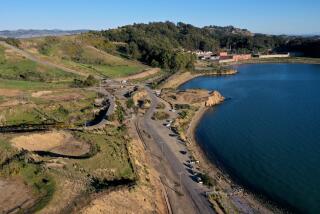Conservancy tour features history of Palisades Park
It was the custom of Santa Monica City co-founder John P. Jones to stroll each evening across Ocean Avenue from Miramar, his Victorian manse, and admire the sunset from atop the coastal sandstone bluffs that fell almost vertically to the beach.
Hoping others might also enjoy the experience, he and Arcadia Bandini de Baker, the widow of city co-founder Col. Robert Baker, donated a strip of land above the palisades to the city in 1892. It stretched from Colorado Avenue to Montana Avenue, and later extended to Adelaide Drive.
Nearly 120 years later, the 1.6-mile Palisades Park, known early on as Linda Vista, maintains that pleasant ocean view for thousands of residents and tourists who snap photos, strum guitars, jog and converse there in a global stew of languages. Chances are, most of the visitors soaking up rays or practicing sun salutations — and the many homeless people using backpacks as pillows — have no idea why two Civil War-era cannons dot the lawn or why a totem pole anchors the northern end.
“Palisades Park is really well-known, but many people don’t know it,” said Ruthann Lehrer, a former landmarks commissioner who runs the Santa Monica Conservancy’s educational programs. The park is, she said, “a storehouse of treasures chronicling the history of Santa Monica and California.”
Come Sunday, people will have the chance to learn more about this destination at the nation’s western edge when the conservancy presents its first tour of the park, with docents revealing tidbits about its storied personalities, landscaping, artworks, monuments and historic structures.
Those include a redwood craftsman-style pergola, built in 1912 and left to decay until it was dismantled piece by piece in 1984 and restored on a concrete foundation; a plaque honoring humorist and entertainer Will Rogers suggesting, inaccurately, that Route 66 ended at the park; and the two cannons, acquired from the Veterans Administration and installed in 1908, possibly as a tribute to Jones and Bandini for donating land in the Sawtelle community for an Old Soldiers Home. Both cannons are aimed at the Santa Monica Pier, built in 1909.
In the beginning, the parkland was scruffy. The city planted grass, Monterey cypress and eucalyptus trees (at the suggestion of Venice developer Abbot Kinney, a promoter of the Australian trees). Park development progressed under Park Commissioner Edward Sweetzer, who donated his salary to buy trees, according to a conservancy report.
The park now boasts more than 30 species of trees, including two twisted varieties — pink melaleucas and Australian tea trees — with ground-hugging branches.
Inspired by the formal beaux-arts principles of the City Beautiful movement, landscape architect I.G. LeGrande in 1913 presented a park plan featuring walkways, planters, gazebos and fountains. The longitudinal pathways, colonnades of palm trees and redwood pergola date from that era.
The park has evolved. Sandstone bluffs have eroded. In the 1930s, Lehrer said, a couple described riding a landslide to the bottom.
Old and modern mix. A stone monument marking the 400th anniversary of explorer Juan Rodriguez Cabrillo’s discovery of Santa Monica Bay in 1542 stands just steps away from the contemporary Overlook Beacon, a sculpture evoking a sailing ship with mast and wooden deck.
At Wilshire Boulevard rises the cast concrete Art Moderne statue of Saint Monica, the city’s namesake. On the back is inscribed, “Public Works of Art Project, 1934,” a reference to the federally funded New Deal program aimed at employing artists during the Depression.
At Idaho Avenue stand massive gates made from boulders and decorated with tiles by Ernest Batchelder, a Pasadena tilemaker famed primarily for his fireplaces.
At the northern end of the park, at the Ocean Avenue curve, is the totem pole depicting a raven, a fish, a bear and a wolf. It was created by Chilkat Tlingit Indians in Alaska and donated by a charter member of the Santa Monica Rotary Club.
In recognition of its value as a historic resource and cultural landscape, the park was designated as a Santa Monica landmark in 2007.
“What I really love about the bluffs is that everybody uses them,” said Yuriko Byers, a yoga teacher who lives in Santa Monica and visits the park five days a week. “I hope the park never goes away.”
In Lehrer’s view, the most significant stop will be the carved limestone bench commemorating Jones. It was designed in 1923, after his death, by his son-in-law, the renowned architect Robert Farquhar. Cracked and crumbling in spots, the bench nonetheless maintains its grandeur and elegance.
The park “represents so much of Santa Monica’s past,” said Nancy O’Neill, a retired reference librarian for the Santa Monica Public Library. “It’s the sort of thing you want people to know about their town.”
Reservations for the tour are recommended. For information, visit the conservancy’s website at https://www.smconservancy.org.
More to Read
Sign up for The Wild
We’ll help you find the best places to hike, bike and run, as well as the perfect silent spots for meditation and yoga.
You may occasionally receive promotional content from the Los Angeles Times.







